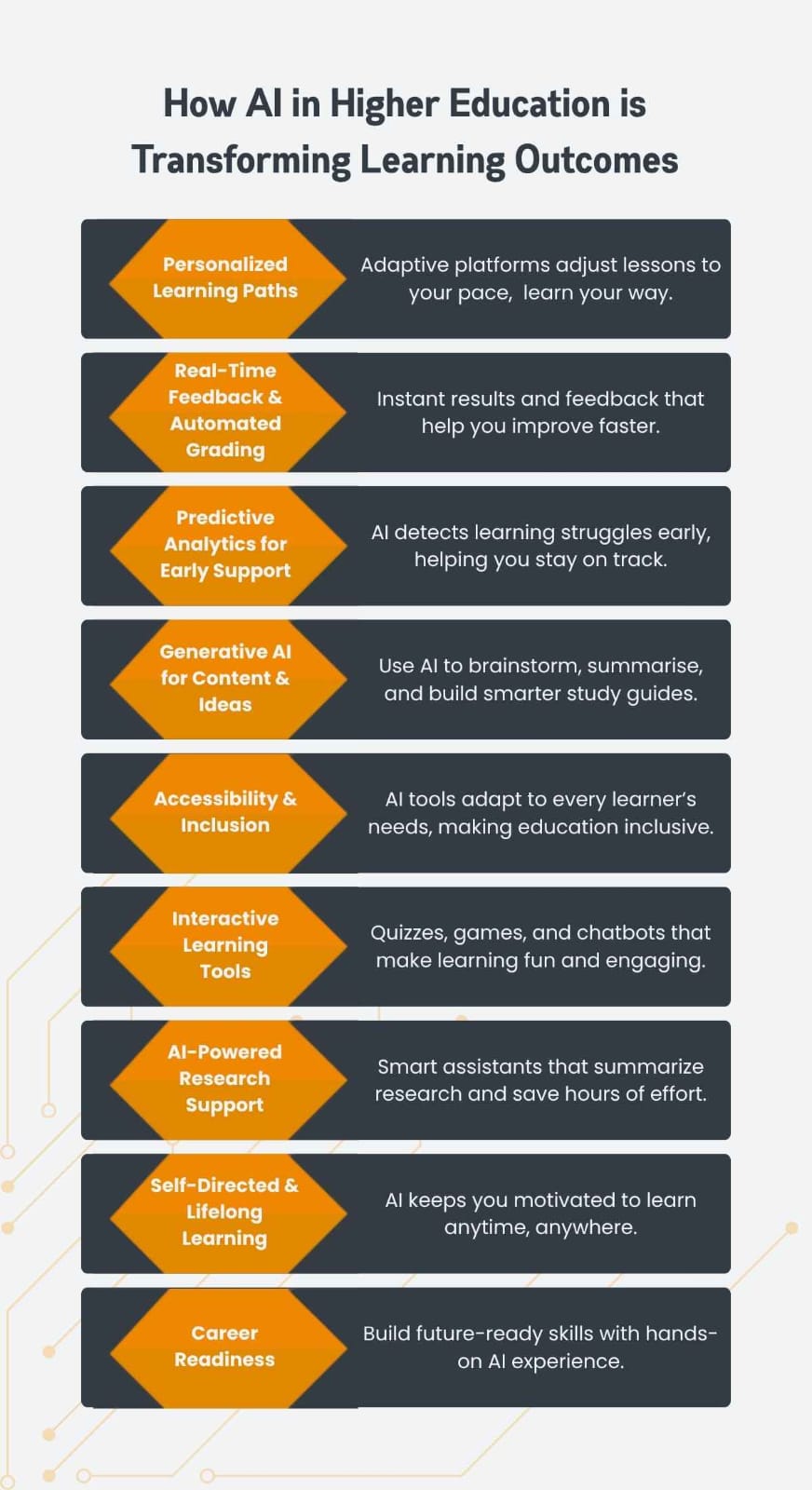
9 Essential Ways AI In Higher Education Can Improve Learning Outcomes
Every classroom feels a little different these days. Textbooks still matter, but more students are turning to tools that adapt to them. AI in higher education is quietly helping with things like giving feedback faster, spotting strengths and weak spots, and letting students learn at their own pace.
According to the Digital Education Council’s 2024 Global AI Student Survey, 86% of students already use AI in their studies, with 54% of students using it every week. That shows AI is no longer optional, it’s part of how students are learning, organizing, and completing their work.
In this article, I’m going to share 10 essential ways AI in higher education can improve learning outcomes and why it’s becoming a key part of today’s college experience. So, let's get started.
9 Essential Ways AI In Higher Education Can Improve Learning Outcomes
What is AI in Higher Education?
Why the Role of AI in Higher Education Matters
9 Smart Ways AI in Higher Education is Boosting Learning Outcomes
1. Personalized Learning Paths for Every Student
2. Real-Time Feedback and Automated Grading
3. Predictive Analytics for Early Intervention
4. Generative AI in Higher Education for Content Creation & Idea Support
5. Supporting Accessibility and Diverse Learners
6. Increasing Student Engagement Through Interactive Tools
7. Supporting Research and Academic Projects
8. Encouraging Self‑Directed and Lifelong Learning
9. Preparing Students for Future Careers
What is AI in Higher Education?
When you hear AI in higher education, it means using artificial intelligence tools inside colleges and universities to help with teaching, learning, and even how the school runs.
These systems might look at how you’re doing in your courses, suggest what to study next, give feedback right away, or help your professor design lessons.
For example, a recent survey found that more than 80% of students at a U.S. college reported using generative-AI tools for learning purposes by early 2025. So rather than simply sitting in class listening and hoping to understand, you might get a learning path built just for you.
Yeah, that’s the promise of AI in higher education.
AI in higher education is just the beginning. Read how smart AI agents are making waves in school learning, too: Smart AI Agents For Education Are Reshaping School Learning
Why the Role of AI in Higher Education Matters

Now that you know what it is, let’s see why it counts. The role of AI in higher education is becoming key because many students don’t learn the same way. Some need more time, some are ahead, and some have other commitments like jobs or family.
With AI, the school can assist each of these types of students more fairly. Also, schools face big pressures, rising costs, a need for better results, and more students from different backgrounds.
So, using AI in higher education helps schools adapt. For instance, data shows 45% of higher-education institutions are deploying AI to personalize student learning. That means instead of a one-size-fits-all class, there’s a chance for one-size-fits-you.
9 Smart Ways AI in Higher Education is Boosting Learning Outcomes

1. Personalized Learning Paths for Every Student
One of the most exciting ways AI in higher education boosts learning outcomes is by offering personalized learning paths. Think of it like a map made only for you, showing where you are now, how fast you move, and which spots you’ve already mastered.
With adaptive platforms, if you’re doing well in one topic, you can jump ahead. If a concept is sticking, the system gives you extra practice instead of pushing you to keep up with the class. As a result, you don't get bored, you’re not left behind, and you’re learning at your own pace.
That matters because people learn differently. Some need more time with visuals, some need extra problems, and some simply grasp things quickly. When the path is tailored, your learning outcomes improve because the journey fits you, not some generic class average.
2. Real-Time Feedback and Automated Grading
Waiting forever for an exam or essay result can be frustrating, it slows your progress. By using AI in higher education, you can get feedback much faster.
For example, when you submit work, automated grading tools can examine your answers, highlight mistakes, and show where you need to improve. Because of this, teachers who use AI feedback tools report that they spend significantly less time on remedial work.
One study noted faster turnaround and more meaningful feedback. What this means for you is that you learn immediately, not in a week.
You can correct a misunderstanding, revisit the topic, and move on stronger. That quick loop – submit, get feedback, and improve, is pure gold for boosting learning outcomes.
3. Predictive Analytics for Early Intervention
Here is something that feels like a friendly alarm system: when universities use AI in higher education, they can identify signs that a student might struggle, before it becomes a big issue.
AI tools can track patterns in how you’re learning, like participation or assignment progress, and alert teachers or advisors when something seems off. This early warning allows support to step in quickly.
When issues are addressed sooner rather than later, you can get back on track faster and amplify your learning gains. Early intervention like this is simple but powerful – notice problems early, provide help, and get better results.
4. Generative AI in Higher Education for Content Creation & Idea Support
Generative AI in higher education helps you create and organize ideas quickly. It can suggest topics for essays, make study guides, simulate experiments, or help you build practice questions, too. They don’t replace you, they save time on repetitive tasks or initial drafts.
According to Arxiv, over 80 % of university students are using generative AI in some form to support learning. That’s a huge number, showing how students rely on AI to work smarter and faster.
But the key is to use AI as support, not as a replacement for your thinking. That’s how knowledge gains improve, by combining your effort with smart assistance.
5. Supporting Accessibility and Diverse Learners
Not everyone learns the same way. Some need visual aids, some need language support, and some learn best interactively. AI in higher education helps level the playing field. Tools can translate content, read text aloud, or adjust lessons to fit your learning style.
When the learning environment adapts to you, you feel included rather than left behind. AI doesn’t replace teachers; it works alongside them to make education accessible for everyone.
For students who face barriers, this personalized support makes learning easier and more enjoyable. It helps improve their results naturally.
6. Increasing Student Engagement Through Interactive Tools
Learning doesn't mean reading books only or listening to lectures, it also means staying curious and involved. AI in higher education makes learning interactive.
It can create quizzes that adapt to your level, mini-games that teach tricky concepts, or chatbots that answer questions instantly. Imagine studying history and suddenly being able to interact with a timeline that reacts to your choices or answers questions in real-time.
This kind of engagement keeps you focused and helps ideas stick. When students interact with content instead of passively consuming it, they learn faster and remember more.
Again, AI doesn’t replace teachers, it makes learning feel alive and personal.
7. Supporting Research and Academic Projects
AI in higher education is a great partner for research. Instead of spending hours sifting through hundreds of articles, AI tools can summarise findings, highlight key points, and even suggest related studies.
For students working on papers or projects, this saves lots of time and lets you focus on your own ideas. It’s like having a smart research assistant that never sleeps.
By helping you organize, analyze, and synthesize information quickly, AI makes sure your research is more accurate, thorough, and effective. This leads to better grades, deeper understanding, and stronger learning outcomes overall.
8. Encouraging Self‑Directed and Lifelong Learning
AI tools also make it easier to learn independently. They can recommend what to read next, suggest exercises, and provide reminders for practice.
When learning is self-directed, you start taking responsibility for your progress, which strengthens your skills over time. AI in higher education gives you freedom while keeping you guided, like a coach who lets you run your own race but steps in when you drift off course.
Over time, students who engage in self-directed learning with AI tools develop better critical thinking and retention, enhancing learning performance far beyond the classroom.
9. Preparing Students for Future Careers
Finally, AI in higher education doesn't only assist in grades or assignments, it also helps in preparing you for the real world. Employers increasingly expect graduates to understand AI tools and digital collaboration.
By using AI in your studies, you’re practicing skills that matter, such as data analysis, problem-solving, efficient research, and collaboration with digital systems. According to a World Economic Forum report, more than 60% of jobs in 2025 will require some AI or digital literacy.
That means AI in higher education boosts learning outcomes and makes you career-ready as well. The work you do now is directly preparing you for tomorrow.
Practical Steps for Institutions and Learners

For Institutions
Create an AI-literacy program so both faculty and students know how to use the tools effectively.
Develop clear policies on ethical AI use (assessment, data, transparency).
Pilot AI tools in low-stakes settings and scale up gradually.
Use analytics to track success metrics and iterate.
For Learners
Take time to understand how AI tools can help you (not just use them mindlessly).
Ask for resources if your institution offers them, many don’t yet.
Use AI for idea generation and learning support, but stay engaged critically, not passively.
Stay aware of academic integrity rules and balance tool use with your own thinking.
Final Word from Purely Startup
When AI in higher education is used well, it can make a meaningful difference in how students learn, how faculty teach, and how institutions support everyone. The 9 paths I’ve listed show where value lies – personalization, feedback, prediction, engagement, and ethics.
But it all comes down to purpose and proper use. If you trust the technology but neglect the strategy, you’ll miss out. If you’re in an institution, start small, get buy-in, and train stakeholders.
If you’re a student, stay curious, use AI as a partner, not a replacement. Because when the tools and the people align, learning outcomes improve, and that’s what matters.
Reach out to us at Purely Startup for a consultation on how your higher-education institution can integrate AI responsibly and effectively. We'll help you shape the future of learning!


